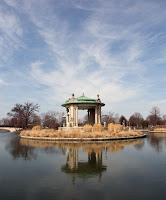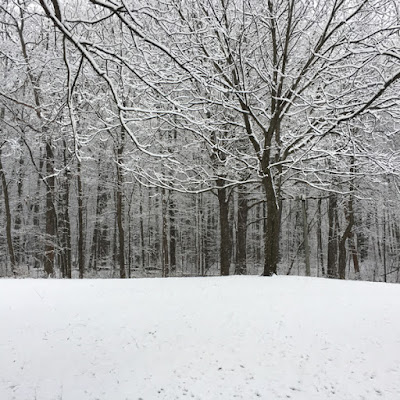 |
| Interstate Falls, Iron County, WI, on the border with Michigan's Upper Peninsula |
The year began with a blast--of cold that is. I went to New York just in time to witness the city shut down for the blizzard that dumped a record-breaking two feet of snow in one day. It was great fun to walk down the middle of 9th Avenue in the snow and even more fun to join thousands of like-minded New Yorkers romping in Central Park. The blizzard obliterated the surrounding city, making Central Park more of an urban wilderness than usual. Making the best of the New York blizzard.
Later in January it was a distinct pleasure to be introduced to the Flying Squirrels in the Milwaukee County Grounds, right in my backyard! Turns out they are native to the area. However, since they are elusive and nocturnal I would never have seen one if not for a chance encounter with Gary Casper, the scientist who is monitoring the squirrels and who took me on a tour of the nesting sites.
In February the wilderness came indoors when the Milwaukee Art Museum opened an exhibit called Nature and the American Vision: The Hudson River School. My review.
In March I drove to Houston, Texas for a conference organized by The Cultural Landscape Foundation. Stopped in St. Louis on the way where their version of New York's Central Park is called "Forest Park." I found it to be more urban than wilderness, but lovely.
The theme of the Houston conference was "Leading with Landscape." I learned a lot about Houston not only from the conference itself but from the two days of guided tours that followed. I also learned that Milwaukee has long had a head start when it comes to preserving and enjoying its landscapes, aka parks and natural areas. I wrote an essay about that for Milwaukee Magazine called What can Milwaukee learn from "Houstonization?"
 |
| Buffalo Bayou Greenway, Houston, Texas |
In April I took a much shorter road trip to visit Chicago's Millennium Reserve for the second time. The Millennium Reserve Initiative, still in its infancy, is intended to create a network of parklands that in total would be the largest urban park system in the country. Much of the system would be comprised of rehabilitated brownfields and post-industrial landscapes sprawling across Chicago's southern edge and into Indiana. Millennium Reserve: visiting Chicagoland's ambitious urban wilderness project.
In May I sought out signs of spring in Milwaukee area parks and found a LOT! I posted four photo essays of my explorations:
Cudahy Nature Preserve: bursting with spring
World Fish Migration Day at Riveredge Nature Center
Mangan Woods blossoms with spring
Review of springtime in Milwaukee (Yes!)
In July I discovered that a new trail had been added along the north bank of the Menomonee River across from Three Bridges Park in the Menomonee Valley. North Bank Trail.
On August 7 the Milwaukee Water Commons held its third annual We Are Water celebration on Bradford Beach. So began a month of water, nature and park-related events.
Citizens Acting for Rail Safety held its second annual Rally on the Milwaukee River to protest oil trains.
One of my biggest adventures of the year was a kayaking expedition with three other river rats down the Menomonee River, my home turf. The projected three-hour tour turned into a six-hour ordeal that we all loved: The constant lure of adventure: Kayaking a surprisingly wild urban river.
 |
| Kayaking the Menomonee River, Wauwatosa, WI |
August 25 marked the 100th anniversary of the founding of the National Park Service. Since the Indiana Dunes National Lakeshore is the closest national park to Milwaukee, I went there to pay tribute: National Park Service turns 100.
September also saw a gratifying resurgence of monarch butterflies along the Monarch Trail in the Milwaukee County Grounds. In what began as an act of faith with no assurance of success, years of lobbying to preserve land and efforts restore habitat seems to be paying off as more butterflies roosted this year than in any of the last ten. Monarch return in force to the Monarch Trail.
In October I went a little crazy.
The month began with a guided tour of the Penokee Hills region of Northern Wisconsin and Michigan's Upper Peninsula. A selection of photos from that trip are on a Flickr album.
When I returned from up north the unrelentingly beautiful autumn led me to spend nearly every day outside in one or another of the Milwaukee region's remarkable parks and natural areas.
If you haven't heard of Brew City Safari, I recommend this hiking club. I went on two hikes with them in October:
Milwaukee River Greenway
Havenwoods State Forest
And it took a whole series of posts to share my experience of autumn in Milwaukee:
Greenfield Park: A walk in the woods
Grant and McGovern Parks
Cudahy Nature Preserve and Falk Park
Humans and Animals: Lake Park and Schlitz Audubon
A magnificent autumn in Milwaukee's parks
 |
| Grant Park beach, South Milwaukee, WI |
Quarry Lake ramble: photographs and poetry was the result.
If you've never seen the Santa Rampage and if you missed my post the first time, you definitely want to check this one out.
When the snow finally showed up I went back to Greenfield Park and to Havenwoods State Forest to be out in it: First snowfall.
The last two weeks of 2016 found me in the most exotic location of the year, Nicaragua. While wilderness eluded me I enjoyed beautiful flowers everywhere I went. Urban Wilderness in Nicaragua, just posted yesterday after my return.
And so ends 2016. If only the political landscape had been as beautiful as the natural one!
Here's to 2017, may it bring humility as well as accountability, peace and determination, greater cooperation but never tolerance of hate. May we live sustainably and spend time in nature frequently whether we live in a city, suburb or rural area.
 |
| Greenfield Park, West Allis, WI |







































